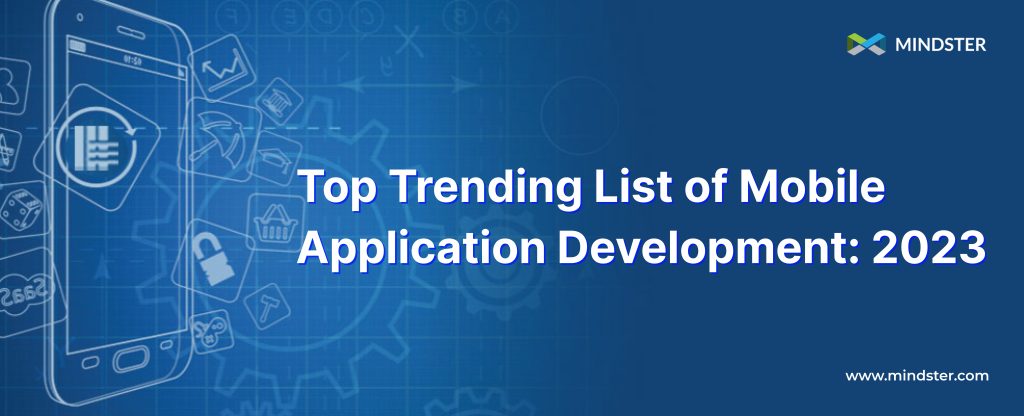Top Trending List of Mobile Application Development: 2024
3 Apr 23 


Realize what lies ahead in 2023 for mobile application development you can satisfy client needs while staying in a continually evolving market.
Introduction
Welcome to the mobile-first era, where mobile software developers and engineers have plenty of opportunities to improve their apps—important given that customers care about every experience.
With the mobile application development market proceeding to fill quickly in 2023, what lies ahead in the approaching year for portable application advancement? To remain competitive, what trends and opportunities must mobile software developers and engineers be aware of?
Here are the Top 12 Mobile App Development Trends for 2023
When customer expectations and market conditions change suddenly, knowing the most recent mobile app development trends can help you pivot.
1. 5G
Users want a powerful mobile network with faster performance, faster data transfer, and lower latency from 5G networks. Utilizing 5G, mobile app developers can add new features like immersive augmented reality (AR) and virtual reality (VR) experiences, enhanced live streaming, and enhanced cloud capabilities to their apps.
2. IoT & Cloud
As businesses strive to establish seamless connections between mobile apps and smart devices, there is an increasing demand for mobile app development services in retail, healthcare, and manufacturing.
Internet of Things (IoT) and the cloud offer critical advantages, including diminished functional expenses, further developed effectiveness, and expanded associations with different stages by means of APIs. Developers, for instance, use IoT mobile applications to monitor the performance of equipment or remote work sites.
3. AI & ML
Artificial intelligence (AI) and machine learning (ML) will continue to be essential components of mobile app development as customers’ expectations for personalized app experiences rise. Apps’ personalization of search, chatbot engagement, and app authentication will be driven by real-time data collection and user behavior analytics for frictionless user journeys.
ML can customize news feeds using analytics, provide AI-powered chatbots that know a customer’s history and preferences for communication, and detect fraud, suspicious activities, and potential information breaches.
4. M commerce
Online purchases are made through a mobile app rather than a mobile web page in mobile commerce, also known as m-commerce. M-business is rapidly developing as additional clients invest energy on applications. In-app payment options and mobile wallets also make it simpler for users to make purchases without leaving the app. Thus, more retailers are building local applications or moderate web applications (PWAs) to give a superior shopping experience.
5. Wearables
Wearable innovation keeps on being broadly taken on, especially in the medical care and sports enterprises. Hi With wearables like fitness trackers, users can now conveniently receive messages and notifications while on the go.
Given that more recent models now have better features and 5G connectivity, it shouldn’t come as a surprise that the demand for mobile apps for wearable technology is growing. App developers who follow this trend will need to concentrate on making interactive, responsive, and user-friendly apps.
6. Beacon Technologies
Beacons were first introduced in 2013, but their use in mobile app development is growing, especially among retail businesses, whose revenue share rose to over 65 percent by 2021 as a result of their deployment. Because it transmits data based on a user’s location using Bluetooth low-energy signals, beacon technology is revolutionizing business.
Real-time, location-specific deals and alerts are among the benefits for customers. Beacons enable businesses to comprehend customer shopping preferences and patterns, resulting in a more individualized shopping experience.
7. AR/VR
Gaming, travel, and live-streaming mobile apps are being transformed by advancements in AR/VR technologies. AR/VR technology lets customers try on clothes, see how a new sofa would look in their living room, or imagine themselves on the beach vacation of their dreams. Customers want deep, immersive experiences. The test for portable application engineers is making encounters that can be gotten to and delighted in on more seasoned cell phones.
8. PWAs and Instant Apps
PWAs, or progressive web apps, fill in the voids left by the majority of native apps and web pages. PWAs are a popular choice for both customers and businesses due to advantages such as a shorter time to market, automatic updates, a lower reliance on internet connections, and faster loading times. Pinterest, Forbes, and Trivago are a few well-known PWA websites.
Essentially, instant applications are acquiring ubiquity since they permit clients to test the application prior to downloading and introducing it. Better performance, enhanced customer service, and lower development costs are all advantages for PWA and instant app businesses.
9. Cross Platform Developments
Cross-platform development implies making a mobile application development utilizing a solitary codebase that can be run on any iOS or Android stage. By coding the app once and then distributing it across multiple platforms, you can save time and money while expanding your customer base with an app that looks and feels the same on all devices. Walmart, Instagram, and BMW are some of the top companies who have implemented cross platform development.
10. Security- in- App Development
Mobile devices are vulnerable to security threats and targeted attacks. According to a Statista survey of mobile users around the world, almost 45% of iOS and Android users would stop using a mobile app and tell their friends to do the same if they thought it wasn’t safe.
Customers will no longer trust an app’s brand if there are any signs that their data is at risk, so testing apps while they are in development is essential for discovering vulnerabilities before they are released.
Adding a biometric login that requires a fingerprint or facial scan to verify the user before providing device access is one solution for increasing app security. Biometrics are unique to the user, never change, and can’t be forged.
Accordingly, app security should remain the number one priority of mobile app development teams in 2023.
11. Less-Coding Development Apps
The app is built by developers using frameworks with user-friendly tools like drag-and-drop, editors, and straightforward APIs. Less-code app development can be done by people who don’t know how to code, and it can save money and time. Your mobile app development team will be able to be more creative, work harder, and get their product to market faster as a result of this.
12. Voice Recognition
Voice recognition technology is one of the fastest-rising mobile app trends, because it fulfills customers’ demand for a quicker response time. Customers use voice commands that the device interprets to carry out a function rather than typing a search request. Customers can, for instance, use Amazon’s Alexa mobile app to ask the AI-powered virtual assistant to check the weather or place an order for groceries.
Why are these Development Trends so Vital?
What comes next in mobile app development will be driven by customer expectations. Customers want to be entertained, work, socialize, and conduct business all from the convenience of their own homes. As a result, they will only accept a high-performing experience on the device of their choice.
Your mobile app development team should be keeping track of metrics like daily active users (DAU) and monthly active users (MAU). This information educates you concerning client commitment as well as give guidance on where to make enhancements or feature specialized issues that could bring about client frustration.
A GitLab survey found that 35% of developers release code twice as quickly, indicating that faster time-to-market is always important in mobile app development. Automated testing, software configuration management, and other tools made possible by a DevOps platform enable developers to better anticipate outcomes and plan projects. As a result, the release velocity increases.
More than anything else, you need to know about the most recent developments in technology, user behavior, and the market, as well as how those developments are changing.
Conclusion
Customers are spending more time on mobile apps because they find it easier to manage their lives online. In 2023, your mobile application development team will have to ensure that apps provide high-performing, frictionless user experiences as customer needs change.
Mobile app developers and engineers will be able to meet customer demands and remain competitive in a market that is constantly changing if they are aware of how the most recent technology trends can improve mobile app development. Mindster is one among the top mobile application development companies who can help in enhancing business with great technology practices and services.
- Agentic AI1
- Android Development3
- Artificial Intelligence28
- Classified App3
- Custom App Development5
- Digital Transformation12
- Doctor Appointment Booking App14
- Dropshipping1
- Ecommerce Apps40
- Education Apps2
- Fintech-Apps37
- Fitness App4
- Flutter4
- Flutter Apps20
- Food Delivery App5
- Grocery App Development1
- Grocery Apps3
- Health Care9
- IoT2
- Loyalty Programs9
- Matrimony Apps1
- Microsoft1
- Mobile App Maintenance2
- Mobile Apps122
- Product Engineering6
- Progressive Web Apps1
- React Native Apps2
- Saas Application2
- Shopify9
- Software Development3
- Taxi Booking Apps7
- Truck Booking App5
- UI UX Design8
- Uncategorized6
- Web App Development1


















Comments